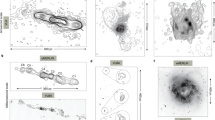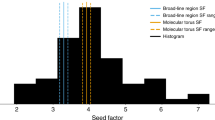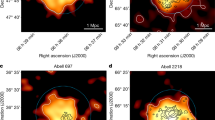Abstract
EXTRAGALACTIC radio sources produce radio waves and narrow emission lines by very different physical processes: synchrotron radio emission arises from lobes filled with magnetized plasma extending over scales of kiloparsecs to megaparsecs, fed by the total kinetic power, Q, of jets driven by a central engine, whereas narrow-line luminosity LNLR arises from gas, typically concentrated in the inner few kiloparsecs, that has been photoionized by a nuclear source. We report here the discovery of a close relationship between Qand LNLR—an approximate proportionality which extends over four orders of magnitude from low-Q radio sources with relaxed structures to high-Q, radio-luminous classical double-lobe radio galaxies. Objects with broad Balmer lines follow the same trend as those without, showing that quasar-like photoion-izing sources are ubiquitous but not always obvious. Moreover, all radio-source central engines channel at least as much power into the jets as is radiated by accretion: this high efficiency implies that the engine is a massive spinning black hole which both powers the jets and controls the accretion rate.
This is a preview of subscription content, access via your institution
Access options
Subscribe to this journal
Receive 51 print issues and online access
$199.00 per year
only $3.90 per issue
Buy this article
- Purchase on Springer Link
- Instant access to full article PDF
Prices may be subject to local taxes which are calculated during checkout
Similar content being viewed by others
References
Fanaroff, B. L. & Riley, J. M. Mon. Not. R. astr. Soc. 167, 31P–35P (1974).
Rawlings, S., Saunders, R., Eales, S. A. & Mackay, C. D. Mon. Not. R. astr. Soc. 240, 701–722 (1989).
Longair, M. S., Ryle, M. & Scheuer, P. A. G. Mon. Not. R. astr. Soc. 164, 243–270 (1973).
Miley, G. K. A. Rev. Astr. Astrophys. 18, 165–218 (1980).
Rawlings, S. in The Interstellar Medium In External Galaxies (eds Hollenbach, D. J. & Thronson, H. A.) 188–190 (NASA Conf. Publ. 3084, 1990).
Leahy, J. P., Muxlow, T. W. B. & Stephens, P. M. Mon. Not. R. astr. Soc. 239, 401–440 (1989).
Rawlings, S. thesis, Univ. of Cambridge (1988).
Laing, R. A., Riley, J. M. & Longair, M. S. Mon. Not. R. astr. Soc. 204, 151–187 (1983).
Scheuer, P. A. G. in Superluminal Radio Sources (eds Zensus J. A. & Pearson T. J.) 104–113 (Cambridge University Press, 1987).
Barthel, P. D. Astrophys. J. 336, 606–611 (1989).
Jackson, N. & Browne, I. W. A. Nature 343, 43–45 (1990).
Bell, A. R. Nature 345, 136–138 (1990).
Rees, M. J., Begelman, M. C., Blandford, R. D. & Phinney, E. S. Nature 295, 17–21 (1982).
Alexander, P. & Leahy, J. P. Mon. Not. R. astr. Soc. 225, 1–26 (1987).
Laycock, S. C. thesis, Univ. of Cambridge (1987).
Northover, K. J. E. Mon. Not. R. astr. Soc. 165, 369–379 (1973).
Macklin, J. T. Mon. Not. R. astr. Soc. 203, 147–155 (1983).
Bridle, A. H. & Vallée, J. P. 86, 1165–1174 (1981).
Burns, J. O., Schwendeman, E. & White, R. A. Astrophys. J. 271, 575–585 (1983).
Saunders, R., Baldwin, J. E., Pooley, G. G. & Warner, P. J. Mon. Not. R. astr. Soc. 197, 287–300 (1981).
Leahy, J. P. Mon. Not. R. astr. Soc. 208, 323–345 (1984).
McCarthy, P. J. thesis, Univ. of California at Berkeley (1989).
Yee, H. K. C. & Oke, J. B. Astrophys. J. 226, 753–769 (1978).
Fabian, A. C., Crawford, C. S., Johnstone, R. M., Allington-Smith, J. R. & Hewett, P. C. Mon. Not. R. astr. Soc. 235, 13P–18P (1988).
Hintzen, P. & Stocke, J. Astrophys. J. 308, 540–545 (1986).
Rawlings, S., Saunders, R., Miller, P., Jones, M. E. & Eales, S. A. Mon. Not. R. astr. Soc. 246, 21P–23P (1990).
Steiner, J. E. Astrophys. J. 250, 469–477 (1981).
Gunn, J. E., Stryker, L. L. & Tinsley, B. M. Astrophys. J. 249, 48–67 (1981).
Saunders, R., Baldwin, J. E., Rawlings, S., Warner, P. J. & Miller, L. Mon. Not. R. astr. Soc. 238, 777–790 (1989).
Yee, H. K. C. & De Robertis, M. M. in Active Galactic Nuclei (eds Osterbrock, D. E. & Miller, J. S.) 457–459 (Kluwer, Dordrecht, 1989).
Author information
Authors and Affiliations
Rights and permissions
About this article
Cite this article
Rawlings, S., Saunders, R. Evidence for a common central-engine mechanism in all extragalactic radio sources. Nature 349, 138–140 (1991). https://doi.org/10.1038/349138a0
Received:
Accepted:
Issue Date:
DOI: https://doi.org/10.1038/349138a0
This article is cited by
-
The fundamental plane of FSRQs based on the black hole spin-mass energy
Astrophysics and Space Science (2023)
-
Gamma-ray emitting narrow-line Seyfert 1 galaxies: Past, present, and future
Journal of Astrophysics and Astronomy (2019)
-
Blazar jets as the most efficient persistent engines
Rendiconti Lincei. Scienze Fisiche e Naturali (2019)
-
The black hole mass, jet power and accretion in blazars and flat-spectrum radio-loud narrow-line Seyfert 1 galaxies
Astrophysics and Space Science (2019)
-
The correlations of multi-wave band luminosity and BLR luminosity in Fermi 2LAC blazars
Astrophysics and Space Science (2017)
Comments
By submitting a comment you agree to abide by our Terms and Community Guidelines. If you find something abusive or that does not comply with our terms or guidelines please flag it as inappropriate.



